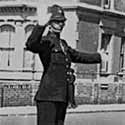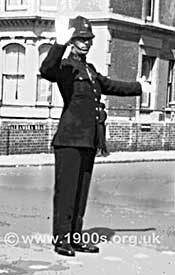
Police arm signals for traffic control and driver hand signals

Arm signals and hand signals from police were common in the past to give directions to drivers and cyclist, as there were of course no traffic lights. This page describes and comments on hand signals from police to motorists; motorists' hand signals to police; motorists' hand signals to other motorists; and the meaning of 'point duty'.
____
By Mike Wheale in association with his father, Les Wheale (born April, 1914) who frequently drove using and responding to arm traffic signals
Arm and hand signals by police on 'point duty'
In the early days of motoring there were virtually no traffic lights. When junctions were busy at certain times, a policeman would go on what was called 'point duty' or 'traffic duty', where he would stand in the middle of the cross roads and direct the traffic. With some crossroads which were continually busy, he would stand on a small pedestal, so that the traffic could see him.
AA men would also stop and direct the traffic in the same way, if they came upon a road junction or accident where motorists were being held up.
The policeman would stand facing one direction with his right arm raised, palm forward, to stop oncoming traffic which was facing him. He might also be holding his left arm out horizontally to stop the traffic behind him. He allowed traffic to proceed with a scooping movement with his right hand; palm facing himself and bent arm rotating towards him.

A policeman on point duty. He is holding his right arm out, palm towards oncoming traffic to show that they should stop, while his left arm is outstretched, back of his hand to the traffic behind, to show that they too should stop and palm facing oncoming traffic to show that those wanting to turn right may proceed. A family photo.
Such signals are intuitive and we still use the same ones ourselves in everyday life.
Drivers' hand signals to policemen on point duty
As all traffic had to stop and wait to be directed by a policeman on point duty, motorists had to use specific hand signals to tell him where they wanted to go.
- If the motorist wanted to go straight on, he placed his right hand against the windscreen (yes, it was invariably a man driving).
- If the motorist wanted to turn right, he sat with his right arm through the door window.
- If he wanted to turn left, he put the back of his right hand with his fingers facing left, against the windscreen.
Cyclists used similar signals.
These signals grew into disuse with the development of traffic lights, trafficators on vehicles and then brake lights and flashing lights.
Drivers' hand signals to other road users
Hand signals were used by motorists to tell other road users where they were going:
- A motorist wanting to turn right, put put his right arm through the open window and held it out straight.
- A motorist wanting to turn left, put his right arm through the open window and rotated it in an anticlockwise direction as if waving on the motorist behind
- A motorist wanting to slow down, put his right arm out through the open window and moved it slowly up and down.
There was also an unofficial hand signal to call motorists behind to pass or overtake. It was to put the arm through the window and use a scooping motion.
Cyclists used similar signals.
If you can add anything to this page or provide a photo, I would be pleased if you would contact me.
Text and images are copyright
sources: early 20th century material
sources: ww2 home front and other material
contact
the webmaster/author/researcher/editor
privacy policy
















